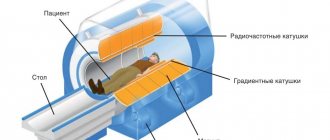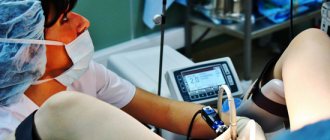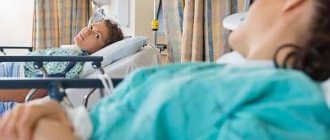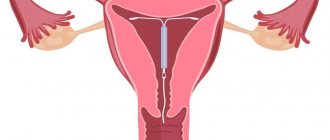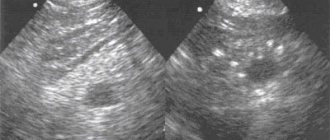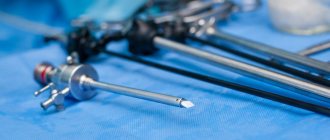- home
- Copy
- Colposcopy
12.02.2019
Colposcopy is a gynecological, low-traumatic procedure that helps the doctor see cervical diseases at the earliest stages. In order for a specialist to visualize the membranes of the cervix under multiple magnification, it is recommended to conduct the study on certain days of the monthly cycle, when discharge from the cervical canal is minimal and can be easily removed with a cotton swab.
Before carrying out the procedure, the doctor is obliged to determine when the patient last had her period and how many days it lasted. This information helps you choose the optimal date on which day of the cycle to do colposcopy of the cervix.
What is the procedure
Colposcopy is a therapeutic and diagnostic procedure that allows a detailed assessment of the condition of the mucous membrane of the vaginal wall and the vaginal part of the uterine cervix. The procedure is performed in a gynecological chair using a colposcope - a device that is a large microscope on a tripod. The device is equipped with eyepieces of different optical powers, allowing for 40x magnification.
Using gynecological speculum, the doctor widens the entrance to the vagina and examines the mucous membrane through a colposcope. The device allows you to examine each area in great detail and, if necessary, carry out additional studies and procedures under vision control.
In the absence of gross pathological changes, he sees a uniformly colored pink mucosa. If any areas are in doubt, the surface is painted with special solutions (Lugol's solution, iodine). Healthy mucous membranes take on a more pink or brown tint, while pathological areas appear paler.
Lesions that cause suspicion to the doctor are subject to biopsy examination. This is done directly during the manipulation. Epithelial cells are collected using special forceps. Also, if necessary, laser coagulation of erosive foci can be performed.
Colposcopy is quite safe and painless and does not require special drug preparation or anesthesia. Only taking a biopsy and performing coagulation can be noticeable, so in these cases local anesthesia can be performed by irrigating the mucosa.
When to do a colposcopy - are there any restrictions?
When a woman visits a gynecologist, you should ask her about the day her menstruation began and recommend that she come for an examination after the end of her menstrual flow. The most optimal time can be called the seventh, eighth day of the cycle. The doctor can calculate the time depending on the duration of menstrual bleeding, taking into account the fact that each woman has her own individual characteristics.
An exception is the situation when colposcopy is prescribed for the purpose of carrying out therapeutic measures. In this case, colposcopy is prescribed a few days before the date when the next menstruation should begin. Then the scab will be rejected from the cervix with menstrual blood, which is most favorable for the healing process of the wound surface.
Recommendations before the procedure
Colposcopy cannot be performed if a woman is receiving local treatment for an inflammatory process and too little time has passed since its completion. It is also contraindicated to do baths or douches on the eve of the appointed day of the study. The information content of colposcopy in this case is low, and the results may be uninformative. You will also have to refrain from taking smears for cytological examination if the woman has douched.
Any local procedures will distort the results of the study, which can lead to late diagnosis of pathological changes in the cervix and the choice of inadequate treatment tactics.
A few days before the test there should be no sexual intercourse, and you should not use any local means of contraception. Their use should be stopped at least two or three days in advance. If a woman came for an appointment and had sexual intercourse the day before, then she should not take a smear for cytological examination. The result of such a smear will be unreliable. During colposcopy, when changes are detected, it may be necessary to take tests for a more in-depth morphological study, so it is important to follow all recommendations and conduct the study at the appropriate time.
Colposcopy is one of the ways to examine the mucous membrane of the cervix using a device similar to a hybrid of binoculars with a microscope and a camera - colposcope.
Colposcopy is performed to determine pathological changes in the cervix. which can be detected upon inspection.
Colcoscopy makes it possible to identify various diseases of the cervix in women. In this regard, it is considered a mandatory procedure during examinations by a gynecologist.
There are no contraindications to colposcopy, no complications are observed.
In addition to the diagnostic function, such a procedure can determine the affected areas of the epithelium and a biopsy of the cervix. You should know that the biopsy was taken from the affected area so that the development of the malignant process was not missed.
Taking a biopsy is a completely painless process, but sometimes some women experience some discomfort.
When is the best time to do a colposcopy?
During menstruation, colposcopy is not done in the middle of the cycle, since a lot of mucus is produced in the cervical canal. So the best time for colposcopy is the end of menstrual days. You should use protection during sexual relations on the eve of the procedure.
The colposcopy method is subjective; the most important point is the competent opinion of the doctor who performs the colposcopy. The gynecologists at our clinic have extensive experience in conducting similar types of cervical examination.
You can make an appointment with a gynecologist directly from the website or by calling the numbers listed below.
If you have any questions, please contact the administrators of our center daily from 8.00 to 21.00 by phone 714-77-98, 714-06-65
If you decide to make an appointment for a consultation or appointment with a doctor, click on the picture
Why is colposcopy performed?
First of all, the procedure is preventive in nature and should be carried out periodically for every woman. This will allow early detection of dangerous pathologies, such as cervical erosion and cancer.
After a routine speculum examination, a gynecologist may prescribe an extended colposcopy to diagnose the presence of cervical ectopia, cervicitis, suspected cancer and other pathological conditions. The procedure is also prescribed for infertility, menstrual irregularities, papillomas and condylomas, to identify the causes of certain changes in a smear and blood test.
Another indication for colposcopy is to obtain a detailed picture of the patient’s condition in preparation for surgical interventions on the uterus and ovaries.
When else can the examination be carried out?
We found out when it is better to do a colposcopy and on what day of the cycle. The third day after menstruation is the reference day, but it is not always possible to get to the doctor on this day. You can do a cervical examination after ovulation. During ovulation, the cervical canal fills with a significant amount of mucus, which interferes with the examination.
To obtain good and accurate results, a woman is recommended to conduct research in the first half of the cycle. Colposcopy is not recommended in the second half of the cycle, due to the development of complications. Examinations after ovulation can cause the development of pain, since the vaginal cavity takes a long time to heal after ovulation. If physical impact is carried out in the form of a colposcopic examination in the second half of the cycle, this can lead to the development of pain and complications.
On what day of the cycle is the manipulation scheduled?
The condition of the female genital organs, including the mucous membranes of the vagina and cervix, largely depends on the phase of the cycle. Mucus, blood and other secretions can significantly complicate the procedure or even make the field unsuitable for examination. Therefore, to answer the question of when is it better to do colposcopy: before or after menstruation, you should remember the phases of the menstrual cycle.
The day your menstrual bleeding begins is the first day of the follicular phase of the cycle, which will last an average of 12 days. At this time, the state of the female reproductive system is under the influence of luteinizing and follicle-stimulating hormones. The beginning of this period (its first 3–7 days) is the menstruation itself. At the end of menstruation, the process of follicle maturation and endometrial growth occurs. There is a minimal amount of discharge during this phase, including mucus, so the time from the 5th to the 10th day of the cycle is the best for colposcopy. Nothing prevents the doctor from examining the mucous membrane and getting an idea of the condition of the organs.
Is it possible to do a colposcopy during menstruation? No. During menstrual bleeding, the entire mucous membrane of the vagina and cervix is covered with bloody discharge. The field under study is completely closed and the research results will not be reliable.
On days 7–14 of the menstrual cycle (this time depends on the individual characteristics of the woman), ovulation occurs, that is, the release of a mature follicle from the ovary. This process lasts about 3 days and is accompanied by the release of a large amount of mucous secretion, especially in the cervical canal. That is why colposcopy on any of these days may not be informative enough. It is better to refuse manipulation during the ovulatory phase.
After ovulation, until the onset of the next menstruation, the hormones progesterone and estrogens predominate in the blood. The luteal phase of the cycle, or the phase of formation of the corpus luteum, begins. During this period, the mucous membrane of the genital tract becomes congested and very sensitive to any damage. This explains the fact that colposcopy before menstruation is acceptable for emergency purposes, but undesirable due to the high risk of injury and bleeding. But on the contrary, it is advisable to perform coagulations exactly 2–3 days before the onset of menstruation, since in this case the postoperative crust will disappear faster.
To summarize: the optimal period for colposcopy is the first half of the cycle, namely from 5 to 10 days after the start of the menstrual period, immediately after the end of the last menstruation. It is acceptable, but not advisable, to conduct a study before menstruation. The procedure is not performed during menstrual bleeding!
Contraindications
Colposcopy of the cervical canal has a number of contraindications:
- It is possible to safely conduct an examination after childbirth only after 2 months. During this period, any discharge should end.
- After an abortion (curettage, surgical and other types), colposcopic diagnosis is carried out no earlier than the 4th week.
- When performing cryodestruction or cauterization to treat cervical ectopia, colposcopy is used only after complete healing of the mucosa.
The extended method is used in the same time frame as the regular one. However, the use of staining substances necessary to detect modified areas and further biopsy of the cervix does not allow diagnosis in the following cases:
- ectocervix atrophy;
- inflammatory process;
- menstruation and other uterine bleeding.
The limitation is the moment of ovulation, when the egg is ready to attach to the endometrium. At this moment, the cervical canal is closed by a mucus plug.
Procedure for menstruation
The study is not informative on any day of menstruation. In addition, the mere presence of bleeding excludes any medical manipulations due to the high risk of infection and injury to the uterine mucosa.
It is impossible to detect diseases of the cervix during a colposcopic examination due to an increase in the volume of mucus, swelling of the epithelium and a large accumulation of blood. This distorts the image and prevents the doctor from examining all areas of the endometrium.
The information content of colposcopy depends on what day of the cycle it is performed. For diagnosis, the procedure is prescribed in the first phase. For therapeutic purposes, for example, during electroconization of the cervix, manipulation is performed at the end of the cycle or immediately before the start of the critical days.
If a woman has a premature period, a colposcopy is done after any vaginal bleeding has stopped.
How to prepare for research
Like almost any medical procedure, colposcopy requires following simple rules during preparation:
- 2 days before this test, refrain from sexual intercourse.
- Douching is not allowed for 3–5 days before the procedure.
- A week before the procedure, you must stop using vaginal contraceptive medications: gels, suppositories, tablets.
- Hygiene procedures should be carried out 3 days before the procedure without using soap, intimate gels, shower gels, etc.
What recommendations should be followed when performing colposcopy?
Before prescribing a procedure for examining the uterine cervix with a colposcope, the doctor conducts a preliminary consultation to identify possible limitations.
Colposcopic examination is not recommended if a woman is prescribed local treatment for inflammation of the genital organs or an insufficient amount of time has passed since its completion (according to experts, at least a week should have passed since the end of treatment).
A few days before the set date of the study, you should refrain from douching, baths and sexual contact. It is also not recommended to use any local contraceptives (spermicides, creams, suppositories).
Following the listed recommendations and performing colposcopy within the prescribed time frame will allow you to obtain reliable diagnostic results and select appropriate treatment.
Recommendations from gynecologists
Colposcopy, although not a traumatic procedure, is still an invasive intervention and is accompanied by damage to the mucous membrane of the vagina and cervix. This creates favorable conditions for pathogens to enter and multiply, and is also associated with bleeding, even minor ones.
To avoid unpleasant consequences, it is not recommended to visit saunas and swimming pools or take a bath within a week after the manipulation. If necessary, use only sanitary pads and avoid tampons.
Do not prescribe or perform douching on your own, do not use vaginal suppositories, tablets, creams without consulting a doctor. Refrain from taking drugs that affect the aggregation properties of blood, that is, drugs that affect blood clotting.
Consequences of the procedure
After a colposcopic examination, a woman may experience slight nagging pain and minor bleeding for some time. This is especially true for extended colposcopy. In order to prevent the development of complications, the following recommendations should be followed for 10 days:
- do not go to the sauna and bathhouse, do not wash in the bathroom, you are only allowed to take a shower;
- do not use tampons, only sanitary pads are allowed;
- Avoid taking any medications that can cause bleeding.
When a colposcopic examination should be performed depends on each individual case, as it is an individual case with a specific diagnostic purpose.
Possible complications
Most women tolerate the examination easily. Problems can only arise in patients with allergies to iodine or acetic acid. Some people complain that they experience bleeding throughout the day after colposcopy. Their appearance is possible during a biopsy, during which the doctor pinches off a small amount of cervical tissue.
Important! When bleeding occurs, gynecologists advise using pads; it is not advisable to use tampons.
In 1-2 days the surface heals and blood stops leaking.
Patients with a low pain threshold may feel discomfort in the uterine area. But by the end of the day it goes away even without the use of painkillers. Discomfort after colposcopy is no greater than after a regular gynecological examination.
Can there be a delay in menstruation after colposcopy?
Examination of the genital organs under a microscope does not in any way affect the functioning of the ovaries. This procedure does not provoke disruption of the regularity of the menstrual cycle.
The delay may be caused by:
- stress if the patient was very worried for several days due to the planned colposcopy;
- pregnancy that occurred during the cycle when the examination was carried out.
Hormonal disorders did not occur after examination.
Scanty periods after colposcopy
Examination under a microscope does not in any way affect the intensity of discharge on menstrual days. Therefore, changes in the nature of menstruation cannot be attributed to colposcopy. If the patient begins to have scanty periods, then she needs to be checked.
A change in the nature of menstruation is observed in those women who were worried about the planned procedure. The cause may be an imbalance of hormones that arose against the background of stress.
Gynecologists advise making sure there is no pregnancy during scanty menstruation. There is a possibility that the woman became pregnant in the middle of the cycle, and the appearance of spotting indicates the threat of spontaneous abortion.

